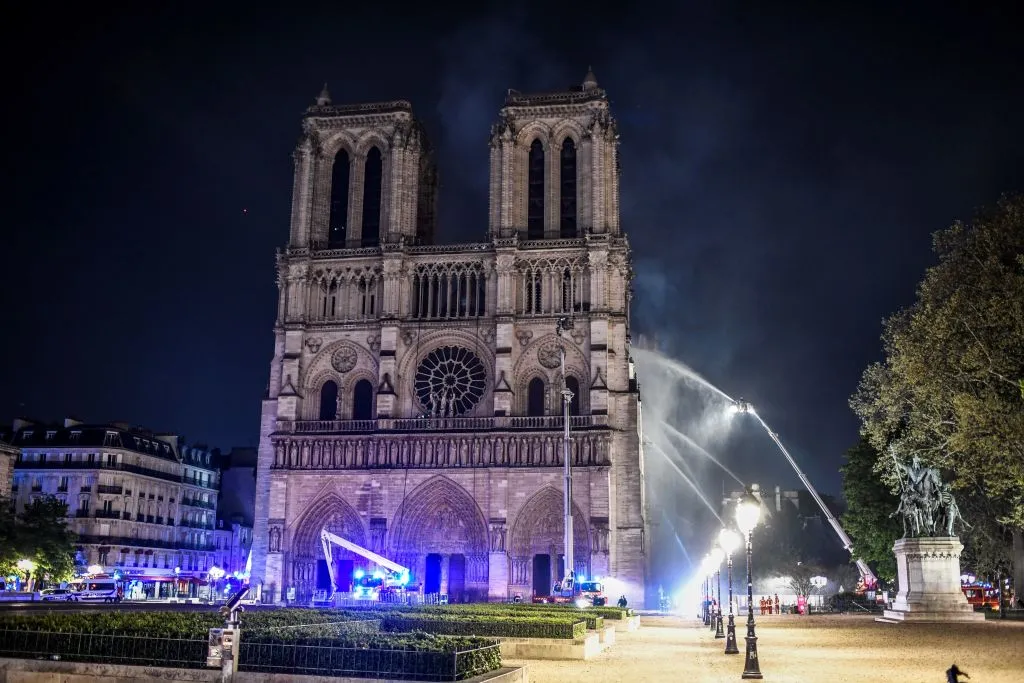
I only visited the cathedral once during my service in the United States Navy in 1967. However, I visited her several times on film starting in 1957.
In 1831 French author Victor Hugo published his novel "Notre-Dame de Paris" in three parts. The work is known more popularly as "The Hunchback of Notre-Dame". It takes place in 1482 under the rule of King Louis XI. The story is described as Gothic-Horror, but I always think of it as a love story in which the wrong man gets the girl at the end.

The novel is considered a major source of the worldwide interest in the cathedral.
The following is a short description of specific characters in the novel and should be compared to the motion picture versions to see the changes made.
The tragic hero is the deaf bell ringer "Quasimodo". He was a baby when the reader first meets him and "Claude Frollo" adopts him, but most film versions of the novel do not show this. "Quasimodo" lives in the bell tower of Notre Dame and loves the music of the bells that have made him deaf. His name means "Half-made" and Victor Hugo describes the bell ringer this way:
---we shall not attempt to give the reader any idea of that tetrahedron nose, of that horseshoe mouth, of that little left eye, obscured by a bristly red eyebrow, while the right was completely overwhelmed and buried by an enormous wart, of those irregular teeth, jagged here and there like the battlements of a fortress , of that horny lip, over which one of those teeth protruded, like the tusk of an elephant, of that hooklike chin, and, above all, of the expression, that mixture of spite, astonishment and melancholy---The antagonist, or not, in the novel is the 36 year old "Archdeacon Claude Frollo". He is not really an evil person bent toward causing pain, or suffering and loves his brother dearly. "Claude" descends into madness and the black arts, because of his failure to properly bring up his brother and "Quasimodo".
"La Esmeralda" is the gypsy girl that is lusted for by "Claude", is in love with "Phoebus" and is truly loved by "Quasimodo". In the novel she is the daughter of "Sister Gudule". Her mother believes "Esmeralda" was eaten by the gypsies in a typical Middle Age superstition. Her mother is alive in the novel, but in the motion pictures "Esmeralda's" back story is never made clear.
"Phoebus de Chanteaupers" is the Captain of the King's archers and saves "Esmeralda" from "Quaismodo". "Phoebus" does not love the girl and only wants to seduce her. He is to be married to "Fleur de Lys" and would never marry, or truly love below his station.
"Clopin Trouillefou" is the "King of the Beggars". In the novel he attempts to rescue "Esmeralda" and get her out of Norte Dame, in which she is under Sanctuary Law , but his actions are mistaken by "Quasimodo" as wanting to harm her.
"Pierre Gringorie" is a poet and playwright who joins the beggars and vagabonds of "The Court of Miracles". After "Clopin" sentences him to be hanged he is saved by marrying "Esmeralda". Later he unknowingly helps "Claude Frollo" turn "Esmeralda" over to the authorities.
"Jehan Frollo" is the teenage brother of "Claude". He is a terrible students, gambles and drinks all of his money away and then goes to his brother for help.
"King Louis XI" is a heartless monarch. He lives in the Bastille for his own protection instead of the royal palace. That at the time was the Louvre.
This is a look at the 15 films made from the story of "The Hunchback of Notre Dame"..
THE LIVE ACTION PRODUCTIONS
ESMERALDA (1905)
The first known motion picture version of Victor Hugo's classic was made in France in 1905 and ran only 10 minutes. The following still is of Henry Vorins the first actor to play "Quasimodo" on screen.

The short had only two on screen credits. They were Vorins and Denice Becker as the gypsy "Esmeralda". Who played "Phoebus", the man in the following still, is unknown.

The director and producer of this film is important from a movie making perspective. Her name was Alice Guy-Blache and is considered the first women film maker.

NOTRE-DAME DE PARIS (1911)
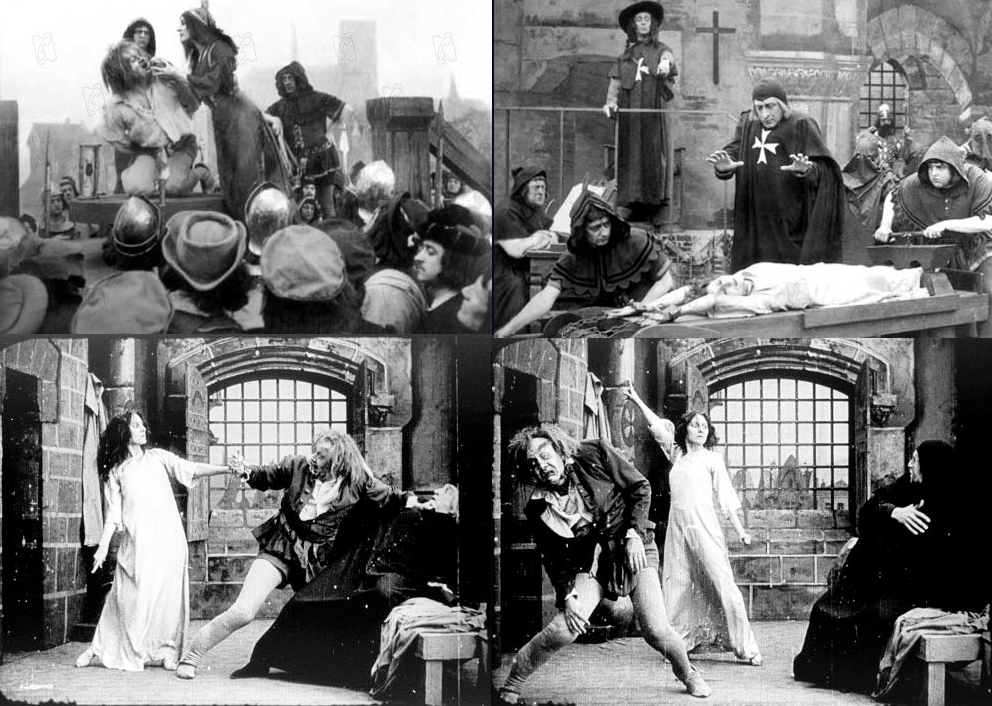
This French film by Pathe Studio, France, and directed by Albert Capellani ran 36 minutes and was released in December 1911. The feature would come to the United States as "The Hunchback of Notre-Dame".
The role of "Quasimodo" was portrayed by Henri "Henry" Krauss. The role of "Esmeralda" was portrayed by Renee Claire Angele Elisabeth Napierkowska using her screen name of Stacia Napierkowska. Rene Alexandre portrayed "Phoebus de Chateaupers" and Claude Garry was "Claude Feollo".
ESMERALDA (1922)
The first non-French production was released in 1922 and came from the United Kingdom. The British film ran 13 minutes and was directed by Edwin J. Collins.
The title role was portrayed by Sybil Thorndike. Who would become Dame Agnes Sybil Thorndike in 1931. Playwright George Bernard Shaw wrote his 1923 stage play "Saint Joan" specially for her. At the time of this production Thorndike was 40 years old. As seen in the following surviving still for the lost film. Sybil Thorndike appears too old for the role of the young gypsy girl.

The role of "Quasimodo" was portrayed by Booth Conway. Annesley Healy was "Claude Frollo" and "Captain Phoebus" was played by Arthur Kingsley.
THE HUNCHBACK OF NOTRE-DAME (1923)
Released on September 2, 1923 was the motion picture many film historians consider the classic version of Victor Hugo's novel. Made in the United States by Universal Studios, than called Universal Pictures, and starring Lon Chaney, Sr, "The Man of a Thousand Faces", as producer Irving Thalberg's publicity now cried out.

The motion picture was directed by Wallace Worsley. Whom Chaney considered his best director along with Todd Browning. The two had made both the crime drama "The Penalty" in 1920 and the lost feature "A Blind Bargain". In which the actor was "The Ape Man", seen below, for the Goldwyn Studios. "A Blind Bargain" is one of the most sought after "Lost Films" of the silent era.

Now Chaney and Worsley brought Victor Hugo's work to the screen like never before. There are three known major cuts of the picture. The original director's cut ran 117 minutes, the general release ran 102 minutes and it was shorten to 98 minutes, because of content in certain parts of the United States. This does not include the extensive cuts made to the motion picture for the 1960 to 1961 half hour "Silents Please" television program.
It was common knowledge that Lon Chaney had wanted to make a version of Victor Hugo's classic and had purchased the rights to the story. However, he could not find a backer for the project in the United States. He made arrangements with a German film company to go to Germany and make the motion picture, but the deal never materialized and the company seemed to disappear from record.

At this point in Lon Chaney's film career. He had 59 feature films, including 1919's "The Miracle Man", 1920's "Treasure Island", 1922's "Oliver Twist" and 77 shorts to his credit.
At Universal Pictures, "The Boy Wonder", 24 year old producer Irving Thalberg, liked the idea of making "The Hunchack of Notre-Dame" into a feature film. The only problem facing him was how to convince owner Carl Laemmle to invest the money. Thalberg sold Laemmle on the idea that it was a love story and reminded him of the box office success Lon Chaney was having for the studio.
The budget for the picture is estimated at $1,250,000. A large amount of that went to building the Cathedral and the streets of Paris. The motion picture was Universal Pictures all time silent box office champ with a Worldwide gross of over $3.5 million dollars. In comparison Lon Chaney's 1925 "The Phantom of the Opera" had a Box Office of approximately $2 million dollars.

Lon Chaney insisted on creating his own make-up for the role. As there were no actual studio make-up department the permission was given. The result is still unbelievable and when you think he did his own stunts wearing a 50 pound hump. The role of "Quasimodo" becomes even more remarkable.

Portraying the role of "Esmeralda" was Patsy Ruth Miller. This was Miller's only major dramatic role. As she would appear in light comedy until retiring from motion pictures in 1931. However, her acting compliments Chaney's as "Quasimodo" and was critically acclaimed at the time.

Norma Kerry was "Phoebus de Chateaupers". Kerry had changed his last name from Kaiser during World War One and would be known to film historians as the "Clark Gable of the 1920's".

Brandon Hurst was "Jehan Frollo". Who was changed into the villain of the piece and the brother of the Saintly Archdeacon He's really freaky in this picture. Among Hurst's work was a major role in John Barrymore's 1920 "Dr. Jekyll and Mr. Hyde". He also was "Merlin the Magician" in the 1931 "A Connecticut Yankee in King Arthur's Court" starring Will Rodgers.

Nigel De Bruieler was "Dom Claude Frollo", or in the opening credits called "Dom Claudio", the Saintly Archdeacon and brother of "Jehan". The character actor would portray "Cardinal Richelieu" in four motion pictures. These were 1921's "The Three Musketeers" and the 1929 part talkie "Iron Mask". Both films had starred Douglas Fairbanks, Sr. Then Du Bruieler appeared in the 1935 production of "The Three Musketeers" starring Walter Abel and 1939's "The Man in the Iron Mask" starring Louis Hayward. That picture is notable for being directed by James Whale and containing the first on screen role of future British Horror actor Peter Cushing as the "Second Officer".

Ernest Torrence was "Clopin" the King of the Beggars and in this version the adapted father of the gypsy "Esmeralda". Torrence was 6 feet 4 inches tall and was known for playing cold-eyed and imposing villains in silent Westerns.

Raymond Hattan portrayed the poet "Gringiore". Hattan would become a familiar "B" Western side kick to such actors as John Wayne and Johnny Mack Brown. His career covered over 421 on screen appearances.
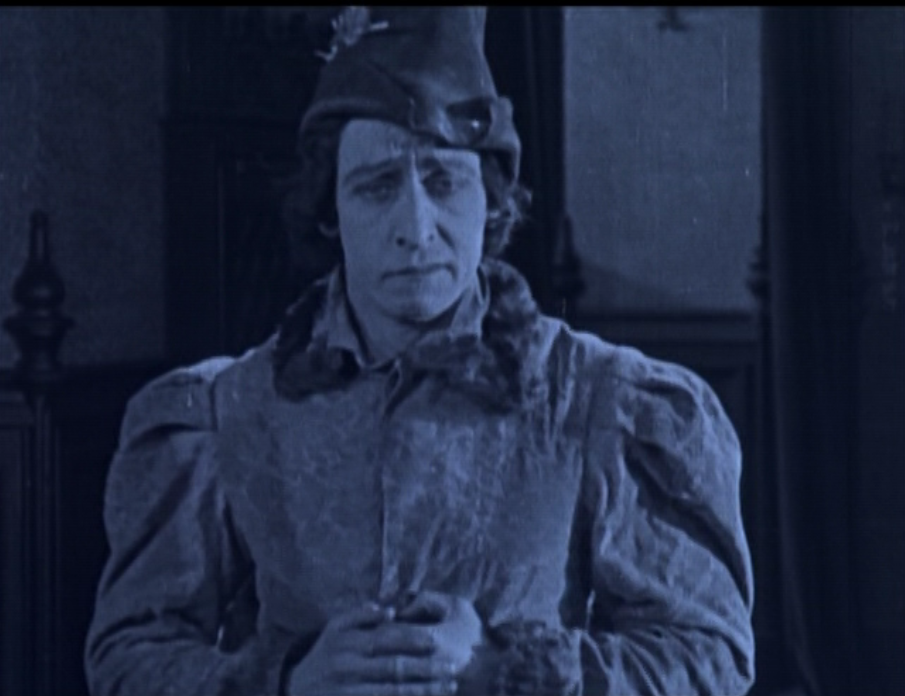
"Winifred Bryson" portrayed "Fleur de Lys". She would appear in only 19 motion pictures.

"Jehan" lusts for "Esmeralda" and gets "Quasimodo" to kidnap the girl. This fails when "Phoebus" happens by and saves the girl. "Quasimodo" is sentenced to be whipped for attempting to kidnap "Esmeralda". While "Jehan" just looks on "Quasimodo" begs for water. It is the gypsy girl who takes pity of the deaf and grotesque bell ringer.
.jpg)


After being freed "Quasimodo" returns to the cathedral his only home. Meanwhile, "Phoebus" and "Esmeralda" are falling in love,

In fact, although engaged to "Fleur de Lys", "Phoebus" has decided to now marry "Esmeralda". "Phoebus" takes the girl to a festival by the King to award him a "Captaincy" in his guards.

"Clopin" leading a group of beggars shows up at the festival and demands that "Esmeralda" return with him to the "Court of Beggars" where she belongs. "Esmeralda" realizes she does not belong with the aristocracy and leaves with her adapted father.
However, later the same night, "Esmeralsa", has the poet "Gringoire", take a note to "Phoebus" to meet her to say good bye.
The jealous "Jehan" stabs "Phoebus" in the back and then blames "Esmeralda". The court sentences her to death, but she is saved by "Quasimodo". Who takes her into Notre Dame and asks for Sanctuary for "Esmeralda" from "Dom Claude".
_14.jpg)
_NRFPT_02.jpg)

From the cathedral "Quasimodo" taunts the people below and shows "Esmeralda" the world as he knows it. What is happening is the bell ringer is also falling in love with the gypsy girl.

The climax comes as "Clopin" leads an attack on the cathedral to rescue "Esmeralda". "Gringoire" goes to the recovered "Phoebus" and tells him whats happening. The Captain gets his man and goes to stop the beggars. At Notre Dame "Quasimodo" finds "Jehan" attacking "Esmeralda" and goes for his former master. "Jehan" is thrown over the ramparts of the church, but he has fatally stabbed the bell ringer three times.
"Phoebus" finds "Emeralda" and the two lovers are reunited. Seeing this "Quasimodo" in joy rings the bells for the last time as "Dom Claude" and "Gringoire" enter the bell tower to witness his death.
THE HUNCHBACK OF NOTRE-DAME (1939)
The following with minor changes, came from my comprehensive article "Victor Hugo's Immortal Love Story: THE HUNCHBACK OF NOTRE-DAME on the Motion Picture Screen" for my readers at:
In 1939 Hollywood was now working under the "Motion Picture Production Code of 1934", or in short, major censorship. For example, specific changes needed to be made to Victor Hugo's characters of the "Frollo" brothers, see next paragraph, as compared to who they were in the novel. The 1923 production, starring Lon Chaney, wasn't under the "Code", but "Universal Picture's" had made some changes to these same characters, but for narrative purposes only. While, the 1939 changes were for the protection of American Morality. As determined by the powerful chief government censor, Will H. Hays, of what was now called "The Hays Office". That would rule the American film industry for the next 20-years.
For the 1939 production, the novel was adapted by Bruno Frank. Frank changed "Archdeacon
Claude Frollo" from a villainous priest to a good man and promoted him to "Archbishop". Leaving Victor Hugo's original character in place would have brought down the wrath of the "Catholic League of Decency" and other Christian religious groups. The age of his brother "Jehan", as in 1923, was raised from a teenager to that of an older man and his first name was now changed to "Jean". Frank added that "Jean" was also now French monarch, Louis XI's, "Chief Justice of Paris". Thus putting the new "Jean Frollo", in charge of prosecuting all crimes in Paris, and, again, as in 1923, the villain of the film, instead of being a troubled teenager.
William Dieterle was the director of the feature. His "Life of Emile Zola", starring Paul Muni, had won the 1937 Best Picture Oscar. Prior to this motion picture Dieterle directed the historical 1939, "Juarez", starring Muni and Bette Davis. He followed this feature film with 1940's, "Dr. Ehrlich's Magic Bullet", starring Edward G. Robinson.
Charles Laughton portrayed "Quasimodo". Laughton was once again nominated for the "Best Actor Academy Award", for his role as "Captain Bligh" in 1935's, "Mutiny on the Bounty".

Maureen O'Hara was "Esmeralda". This was O'Hara's fourth film role and the second picture that "Maureen FitzSimmons" was known as "Maureen O'Hara". FitzSimmons first movie as O'Hara had her appearing opposite Charles Laughton, in director Alfred Hitchcock's adventure film, 1939's,
William Dieterle was the director of the feature. His "Life of Emile Zola", starring Paul Muni, had won the 1937 Best Picture Oscar. Prior to this motion picture Dieterle directed the historical 1939, "Juarez", starring Muni and Bette Davis. He followed this feature film with 1940's, "Dr. Ehrlich's Magic Bullet", starring Edward G. Robinson.
Charles Laughton portrayed "Quasimodo". Laughton was once again nominated for the "Best Actor Academy Award", for his role as "Captain Bligh" in 1935's, "Mutiny on the Bounty".

Maureen O'Hara was "Esmeralda". This was O'Hara's fourth film role and the second picture that "Maureen FitzSimmons" was known as "Maureen O'Hara". FitzSimmons first movie as O'Hara had her appearing opposite Charles Laughton, in director Alfred Hitchcock's adventure film, 1939's,
"Jamaica Inn", with Robert Newton as her love interest.
+101.jpg)
Alan Marshall was "Captain Phoebus". Marshall was a stage actor who appeared in several motion pictures. This same year he appeared in "The Adventures of Sherlock Holmes" starring Basil Rathbone, Nigel Bruce, and Ida Lupino.

Sir Cedric Hardwicke was now "Jean Frollo". In 1935, he was in Victor Hugo's "Les Miserables" portraying "Bishop Bienvenue". In 1936, Hardwicke appeared in one of two motion pictures written by H.G. Wells ,"Things to Come", starring Raymond Massey. In 1937, he was "Allan Quartermain", in the excellent and forgotten British production of "King Solomon's Mines", co-starring the great African American singer Paul Robeson.

Walter Hampden was now "Archbishop Claude Frollo". Hampden was both a major Broadway actor and theater manager.

Thomas Mitchell was "Clopin". He would win the "Best Supporting Actor Academy Award" as "Doc Josiah Boone", in John Ford's, 1939, "Stagecoach". Also in 1939, he was "Diz Moore" in Frank Capra's, "Mr. Smith Goes to Washington", and "Gerald O'Hara" in "Gone with the Wind".

Edmond O'Brien, in his first motion picture role, portrayed "Pierre Gringiore". His next feature film was the comedy-romance, 1941's, "A Girl, A Guy, and a Gob", co-starring in this forgotten picture with George Murphy, and Lucille Ball.

Henry Davenport portrayed the kindly "King Louis XI". The character actor was known for playing country doctors, grandfathers, judges and ministers.

The motion picture opens with a written prologue:
With the end of the 15th century, the Middle Ages came to a close. Europe began to see great changes. France, ravaged by a hundred years war, at last found peace. The people under Louis XI felt free to hope again ~ to dream of progress. But superstition and prejudice often stood in the way, seeking to crush the adventurous spirit of man.

A series of seemingly unrelated events follows the written prologue. As first the audience meets "Jean Frollo", who is determine to stop anything HE deems evil from entering Paris. This includes printing presses and gypsies without a permit. "Frollo" visits a print shop as the picture opens. It is also the
"Day of Fools" and playwright, "Pierre Gringiore", is performing a play until it is interrupted by "Clopin", the leader of the Paris thieves. The play is replaced by the young gypsy woman "Esmeralda" as she dances.


Next, the bell ringer of Notre Dame Cathedral, "Quasimodo", is crowned "King of Fools", but "Jean Frollo" drags him away and back to the cathedral.
The following day, "Esmeralda" seeks out "King Louis XI", to ask him to protect her people. However, she is captured by some guards for entering Paris without a permit. The girl escapes them, runs into Notre Dame, and is given sanctuary by "Archbishop Claude Frollo". A short while later, the Archbishops brother, "Jean Frollo", confronts "Esmeralda", and calls her a heathen.

Later, within Notre Dame, "Esmeralda" meets the kindly "King Louis XI", who agrees to help the gypsies. Afterward, "Jean Frollo" takes the girl up into one of the church towers. On the way up, the two encounter "Quasimodo", who frightens her. "Esmeralda" turns, and runs away from her sanctuary and the church. "Jean Frollo" orders "Quasimodo" to go after the girl and bring her back to him.

"Pierre Gringorie" witnesses the chase and goes for "Captain Phoebus". Who gets his guards and goes after "Quasimodo". He is captured and the love story between "Esmeralda" and "Phoebus" begins.

Later, "Gringorie" accidentally enters the beggars, "Court of Miracles", and is saved from death, by "Esmeralda", who agrees to marry him. "Pierre" takes this seriously, but "Esmeralda" tells him it was just to save him and she loves another.
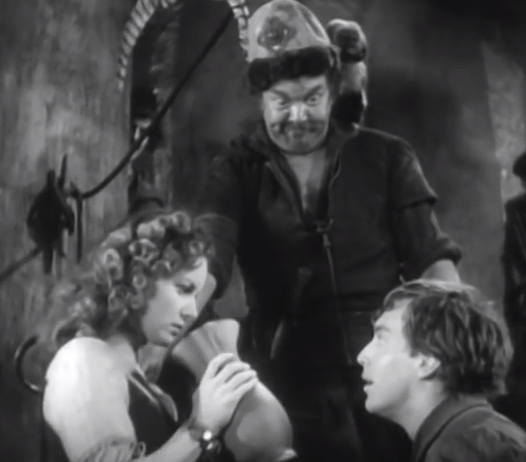
The next day, for his crime, "Quasimodo" is sentenced to be lashed and publicly humiliated. "Jean Frollo" doesn't help the confused bell ringer and ignores his pleas. During his lashings "Quasimodo" asks for water, but not one person comes to his aide until "Esmeralda" appears.



Later "Phoebus" invites "Esmeralda" to a party with the nobles. At the party, "Jean Frollo" turns up, and he confesses his evil lust for the girl.

"Phoebus" approaches the two, and with "Esmeralda", they go off together. In a rage, "Jean Frollo" kills him and then puts the blame upon the gypsy girl.
"Jean" confesses to his brother the "Archbishop", but his brother will not help him as he's a murderer. "Gringorie" attempts to get his "wife" freed, but to no avail. Even after "Archbishop Claude Frollo" proclaims her innocence. A trial is held and "Esmeralda" is sentenced to death.

As she is led on a cart to the execution site surrounded by the "Good" citizens of Paris. Suddenly, "Quasimodo" comes down from the bell tower of Notre Dame, and grabs "Esmeralda". He takes her into the cathedral, and up to his bell tower. While holding "Esmeralda" up, "Quasimodo" calls for "Sanctuary", to the cries of delight by the Paris crowd and the beggars.
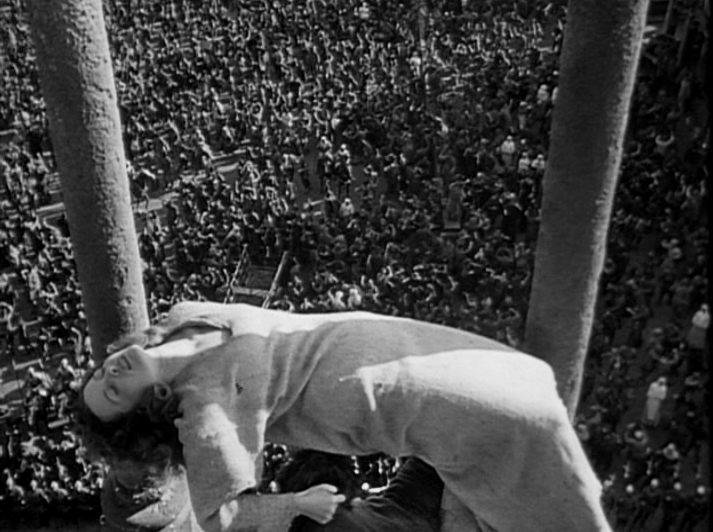
This leads to a second series of events. "Gringorie" prints a pamphlet to save "Esmeralda" and for the gypsies to have the same rights as citizens. He is able to get it to the King to agree. However, the beggars, under "Clopin", attack Notre Dame to save "Esmeralda" and "Quasimodo", and the guards fight them off.
As the battle is occurring, the bell ringer sees "Jean Frollo" harming the gypsy girl. "Quasimodo" throws "Jean Frollo" off the battlements to his just reward.
The King frees "Esmeralda" and the gypsies, and the girl has come to love the poet.
The film ends with "Quasimodo" up in his tower by one of the gargoyles. He is talking to it of his love for "Esmeralda" and says:

Later, within Notre Dame, "Esmeralda" meets the kindly "King Louis XI", who agrees to help the gypsies. Afterward, "Jean Frollo" takes the girl up into one of the church towers. On the way up, the two encounter "Quasimodo", who frightens her. "Esmeralda" turns, and runs away from her sanctuary and the church. "Jean Frollo" orders "Quasimodo" to go after the girl and bring her back to him.

"Pierre Gringorie" witnesses the chase and goes for "Captain Phoebus". Who gets his guards and goes after "Quasimodo". He is captured and the love story between "Esmeralda" and "Phoebus" begins.

Later, "Gringorie" accidentally enters the beggars, "Court of Miracles", and is saved from death, by "Esmeralda", who agrees to marry him. "Pierre" takes this seriously, but "Esmeralda" tells him it was just to save him and she loves another.

The next day, for his crime, "Quasimodo" is sentenced to be lashed and publicly humiliated. "Jean Frollo" doesn't help the confused bell ringer and ignores his pleas. During his lashings "Quasimodo" asks for water, but not one person comes to his aide until "Esmeralda" appears.



Later "Phoebus" invites "Esmeralda" to a party with the nobles. At the party, "Jean Frollo" turns up, and he confesses his evil lust for the girl.

"Phoebus" approaches the two, and with "Esmeralda", they go off together. In a rage, "Jean Frollo" kills him and then puts the blame upon the gypsy girl.
"Jean" confesses to his brother the "Archbishop", but his brother will not help him as he's a murderer. "Gringorie" attempts to get his "wife" freed, but to no avail. Even after "Archbishop Claude Frollo" proclaims her innocence. A trial is held and "Esmeralda" is sentenced to death.

As she is led on a cart to the execution site surrounded by the "Good" citizens of Paris. Suddenly, "Quasimodo" comes down from the bell tower of Notre Dame, and grabs "Esmeralda". He takes her into the cathedral, and up to his bell tower. While holding "Esmeralda" up, "Quasimodo" calls for "Sanctuary", to the cries of delight by the Paris crowd and the beggars.

"Quasimodo" attempts to befriend "Esmeralda" and tells her of how the bells, that he loves, made him deaf.

This leads to a second series of events. "Gringorie" prints a pamphlet to save "Esmeralda" and for the gypsies to have the same rights as citizens. He is able to get it to the King to agree. However, the beggars, under "Clopin", attack Notre Dame to save "Esmeralda" and "Quasimodo", and the guards fight them off.
As the battle is occurring, the bell ringer sees "Jean Frollo" harming the gypsy girl. "Quasimodo" throws "Jean Frollo" off the battlements to his just reward.
The King frees "Esmeralda" and the gypsies, and the girl has come to love the poet.
The film ends with "Quasimodo" up in his tower by one of the gargoyles. He is talking to it of his love for "Esmeralda" and says:
Why was I not made of stone, like thee?".
NOTRE-DAME DE PARIS (1956)
Above is the actual title for this French and Italian co-production. When the picture was released in the United States, in 1957, the title was changed to "The Hunchback of Notre Dame". Initially there had been a problem with what to call the movie in the United States, because RKO's 1939's version still held the rights to that title, but by the date of release it had become available..


French director Jean Delannoy was in charge of the first production of the Victor Hugo's novel in Technicolor and CinemaScope. There were three writers on the project. Two of them were French Jean Aurenche and Jacques Prevert. The third was American playwright and screenplay writer Ben Hecht. Hecht had written both the novel and screenplay for the original 1932 "Scarface", the screenplay for the original 1937 "A Star is Born". Among his other work were Howard Hawks 1951's "The Thing from Another World", 1955's "Ulysses" starring Kirk Douglas as Homer's hero and 1957's "Legend of the Lost" that starred John Wayne and Sophia Loren.
This screenplay is the closest to the actual novel still, as of this writing, and contains Victor Hugo's actual ending.
The two leading actors were the only one's speaking English on the set. As was typical with many French and Italian productions. The actors spoke their normal language and were dubbed into the language of the country the movie would be shown.
Anthony Quinn was "Quasimodo". Earlier in 1956 Quinn had been seen as "Paul Gauguin", opposite Kirk Douglas as "Vincent Van Gogh", in the excellent biography "Lust for Life". The year before this picture Anthony Quinn was also seen in the Italian language film "Ulysses" with Douglas also.
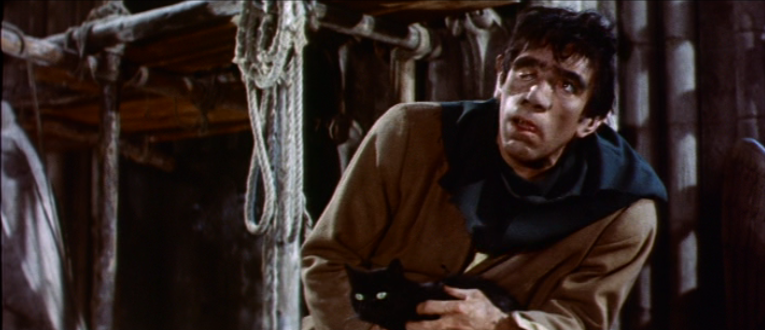
Gina Lollobrigida was "Esmeralda". Earlier in 1956 she had come between aerialists Burt Lancaster and Tony Curtis in the European set circus film "Trapeze".

French actor Jean Danet was "Phoebus de Chateaupers". Danet was a Gay activist in France during his lifetime and joined in many protests early in his career.

"Claude Frollo" was portrayed by Alain Curry. .

Maurice Sarfati was "Jehan Frollo". The French actor's only American made motion picture was 1966's "The Lost Command". The World War 2 picture starred Anthony Quinn, George Segal and French actor Alain Delon. Note that "Jehan" is a young man, more in line with the Hugo novel, but not a teenager/
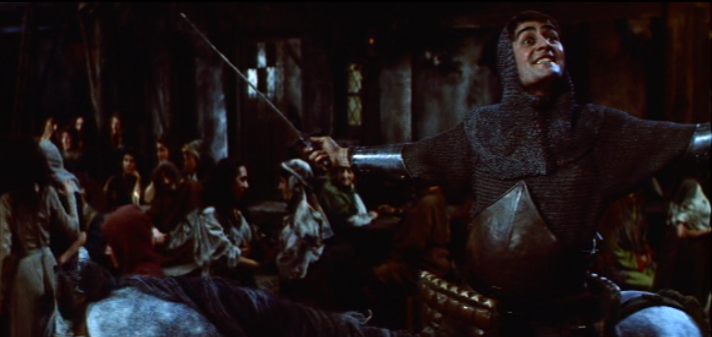
Phillipe Clay is "Clopin Trouillefou". Clay was a known French mime and singer.

French actor Robert Hirsch portayed "Pierre Gringorie". He had been a member of the "Societarie Comedie Francaise" for four years prior to making this picture.

Jean Tissier portrayed "Louis XI" and in this story "Louis" isn't kind as in the 1939 picture, but as portrayed by Victor Hugo as historically evil. Far worse than "Claude Frollo". By the end of his career Tissier had appeared in over 250 different film roles.
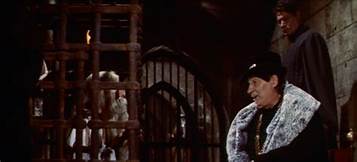
Note the make-up, below, on Anthony Quinn as "Quasimodo". He only has a slight bend to his spine and his face is not majorly deformed as in previous films. Quinn plays "Quasimodo" more as a disabled human being with deep emotions than the actors in the previous productions.

The film opens with "Grinorie's" play beginning and the audience hating it and wanting the "Feast of Fools" to start. "Claude Frollo" is walking near Notre Dame and sees "Esmeralda" perform a dance and it is obvious he lusts for her.
The contest for the "King of Fools" starts and "Esmeralda" suggests "Quasimodo". The night as the beggars and thieves are still carrying "Quasimodo" on his throne. "Claude Frollo" appears and removes his crown and robe, but "Quasimodo" retrieves a whistle> As the deaf bell ringer was able to hear it and it brought real joy to him.

As the two are heading back to Notre Dame. "Esmeralda" is walking down the darken street and the lust he feels toward her comes over "Frollo". Who orders "Quasimodo" to bring her to him. This will lead to the appearance of "Phoebus" and his soldiers and the capture of the bell ringer.
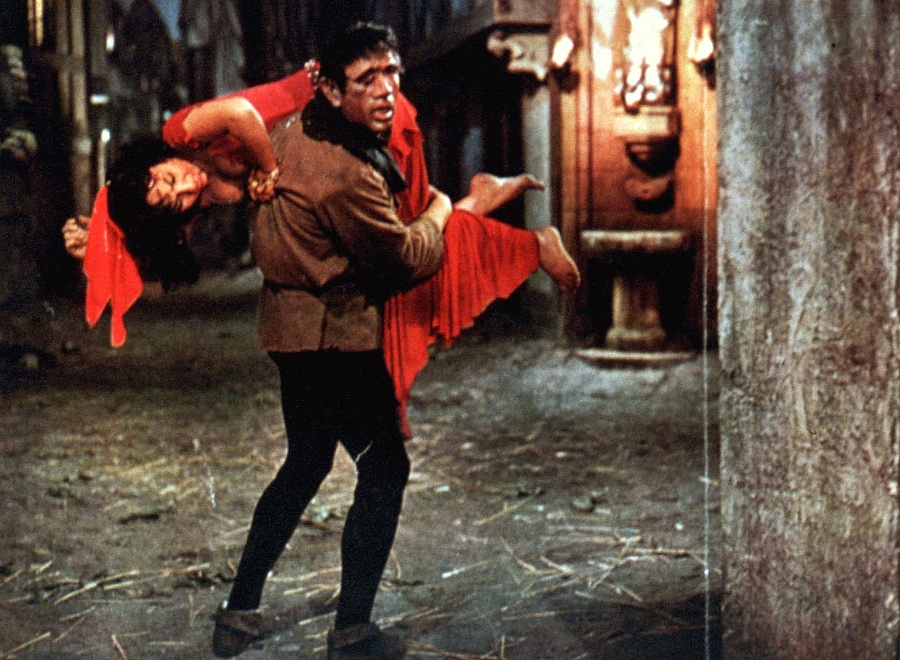
"Phoebus" tries to take "Esmeralda" to an inn he uses with women, but she teases him and leaves. "Gringorie" is walking down another darken street and meets a beggar with one leg who demands money. "Gringorie" walks away, but meets another beggar and than even more beggars ending up an uninvited guest at the "Court of Miracles". He is about to be hanged, but "Esmeralda" offers to marry him and saves his life.
Of course she will not go to bed with him, but the two become a team using her goat, that appears to spell, to make money off people. "King Louis XI" goes to "Claude Frollo" to find out, if he can really turn lead into gold. He is looking for any means of funding his kingdom.
"Quasimodo" is brought forth to be lashed and as this is going on. He asks for water and is refused. "Claude Frollo" ignores his plea,.but it is "Esmeralda" that brings him some and he thanks her.
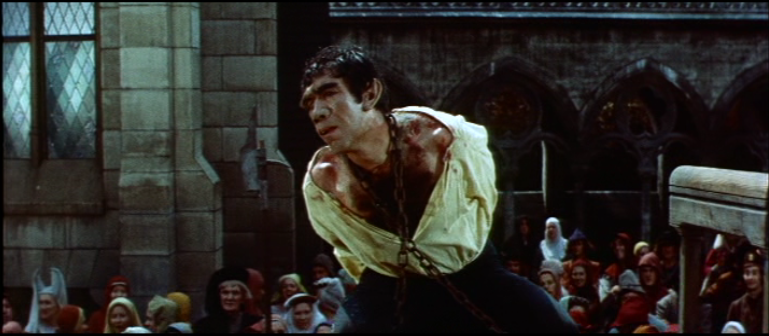

The following day "Claude Frollo" notices "Esmeralda" and "Gringorie" with her spelling goat. The goat picks tiles and spells "Phoebus". "Esmeralda" now meets at the inn with "Phoebus" and was seen going there by the lustful "Claude". Inside he hears the two talking and "Phoebus" jokes about a knife "Esmeralda" has and tosses out the window. It falls in front of "Frollo" who picks it up and stabs him.

"Esmeralda" screams and the owners of the inn look in. She is arrested for the stabbing of "Phoebus" and put on trial. She keeps asking, if "Phoebus" is a live. She is next tortured and sentenced to hang for her crime. The one person that makes the case for conviction is "Claude Frollo". Who is still torn between his lust for "Esmeralda" and his position.

"Esmeralda" is led through the streets to be hanged. Along with her goat that the court considers a familiar of the gypsy witch. "Quasimodo" see this, throws down a rope from the ramparts of Notre Dame, climbs down and grabs the girl. He runs into the cathedral calling for "Sanctuary".
At first "Esmeralda" is frightened, but "Quasimodo" wins her over. However, she has met "Claude Frollo" in the bell tower and confronts him with the truth that he is the one who stabbed "Phoebus".

There are several tender moments in this version between "Esmeralda" and "Quasimodo". Such as the bell ringer showing the gypsy girl his bells and bringing her flowers. It becomes very apparent that "Quasimodo" is in love with "Esmeralda".
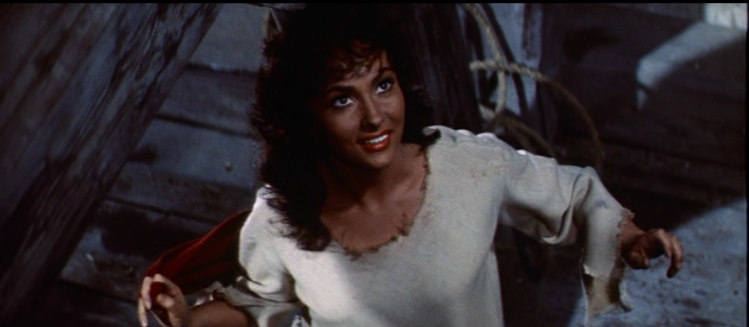
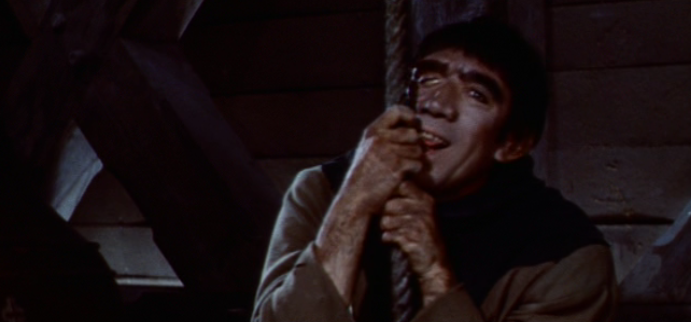


Looking down one day from the bell tower. "Esmeralda" spots "Phoebua" and asks "Quasimodo" to bring him to her.
When "Quasimodo" is finally able to speak to "Phoebus". "Phoebus" tells "Quasimodo" he has no feelings for "Esmeralda" and is to marry, within his station, the boring "Fleur de Lys".

"Claude Frollo" talks to "King Louis XI" about finding a way around the "Sanctuary Law". They discover that if the King declares Notre Dame not a church for one day, which he legally can do, then there is no Sanctuary. Which the King does in return for the loyalty "Frollo" gives him. Meanwhile, "Clopin" and his beggars and thieves decide to storm Notre Dame and rescue "Esmeralda".

However, "Quasimodo" sees the crowd and thinks they're coming to harm the girl. So he bars the doors and from the ramparts of the bell tower starts to drop heavy concrete blocks. He gets from the continuing repairs on the cathedral. He also drops a large wooden brace which the crowd uses as a battering ram.
Also stirring up the beggars is "Jehan Frollo" on a horse. A construction ladder is placed high enough for his to reach the bell tower and "Jehan" claims it. Only to have "Quaismodo" push him away and fall to the ground below dead. While his brother watches unemotionally from a corner of the ramparts. A vat of molten lead is near by and "Quasimodo" now pours it out and it runs over the balcony onto the crow below.
When the King's Bowmen arrive to attack the crowd. "Esmeralda" has been able to run down to the cathedral's doors that are now pushed open. However, the bowmen start firing arrows at the crowd and she is hit by one. "Esmeralda" dies in the arms of "Clopin". Who is himself killed by a sword.

When asked about her "Phoebus" says she was to have been hanged. So carry out the sentence and hang her dead body. "Quasimodo" watches "Esmeralda's" body being dragged from Notre Dame and across the court yard. He sees "Claude Frollo" in the corner looking down at "Esmeralda's" body. In a fit of anger "Quasimodo" grabs "Frollo" and tosses him off the ramparts.
Then in a voice over it is mentioned were "Esmeralda's" body was place after being hung. "Quasimodo" enters the crypt to find it just tossed on the dirty floor. He lays down beside his love. As the audience hears that years later the skeleton's of a women and man were discovered intertwined. When it was attempted to separate the two. They turned to dust and were blown away.

As was the custom in the 1950's. The movie was turned into a comic book by Dell Comics.

HUNCHBACK OF NOTRE DAME (1966)
In 1966 there was a British six part mini-series based upon Victor Hugo's novel, but other than Peter Woodthrope portrayed "Quasimodo", Gay Hamilton was "Esmeralda" and James Maxwell was "Claude Frollo". I could not locate any other information about the production except this photo.

HUNCHBACK OF NOTRE DAME (1977)
This production was made by the British Broadcasting Company (BBC).
Warren Clarke was "Quasimodo". Clarke would appear in motion pictures with Charlton Heston and Clint Eastwood. His first major film appearance was in Stanley Kubrick's 1972 "A Clockwork Orange" as one of Malcolm McDowell's droogs.

Michelle Newell was "Esmeralda". Mostly a British television actress. Newell had appeared with Clarke on the popular series "Coronation Street".
/5.jpg)
Richard Morant portrayed "Phoebus de Chateaupers".

In this production "Claude Frollio" is back to being the Archdeacon of Notre Dame cathedral. The role is portrayed by Kenneth Haigh. Haigh was the British World War 1 flyer who lands on a modern 1960 air field in the first season of the original "Twilight Zone" in the episode "The Last Flight".

Tony Caunter was "Clopin Trouillefou".

Christopher Gable was "Pierre Gringorie".

David Rintoul was "Jehan Frollo".

John W. Ratcliff is "Robin Poussepain" a friend of "Jehan". Below both characters with "Quasimodo".

The production opens with "Gringorie's" play, but the audience isn't interested. Especially "Jehan Frollo" and his friend "Robin" that want to start the "Festival of Fools". "Quasimodo" is elected the "King of Fools". However, "Claude Frollo" objects and starts to take the bell ringer away. When "Robin" draws "Frollo's" attention to the dancer "Esmeralda".

"Gringorie" starts to follow "Esmeralda" and sees "Quasimodo" attempt to kidnap the girl, but is unaware that "Claude Frollo" ordered the bell ringer to do this. "Phoebus" and his bowman arrive and arrest "Quasimodo". "Esmeralda" is captivated by the Captain, but leaves. "Gringorie" wanders into another street and is captured by the beggars and taken to their "Court of Miracles". He is saved from hanging by marrying "Esmeralda".
The production continues with the lashing of "Quasimodo" and "Esmeralda" giving him the water he is asking for. After this sequence the audience sees "Jehan" enter the room that his brother "Claude" is performing alchemy. He begs for more money from " Claude" and then explains what he calls the "squalid melodrama" revolving around the gypsy girl, "Esmeralda', and "Phoebus", "Captain of the Bowman". "Jehan" also tells his brother that the two potential lovers will be together that evening and where.
"Claude Frollo" confronts "Phoebus" about lowering himself in station for a gypsy witch. "Phoebus" permits "Claude" to hide and watch him make his move on "Esmeralda". However, she tells the bowman she must remain chaste. The lustful "Claude" steps into the room from his hiding place and stabs "Phoebus".
"Esmeralda" is put on trial for the "murder", which has not actually occurred, of "Phoebus". She is convicted of the crime, but "Claude" appears at her cell. Telling the girl he can free her, if she becomes his. She refuses for the third time. "Gringorie" attempts to get "Claude" to free her, but "Frollo" wants "Esmeralda" taken to the gallows.

"Quasimodo" stops the execution and throws the executioner into the crowd. He takes "Esmeralda" into the church yelling for "Sanctuary".

Later "Esmeralda" sends "Quasimodo" to "Phoebus". "Phoebus" kicks "Quasimodo" to the ground telling him he doesn't want anything to do with the gypsy girl. Returning to "Esmeralda" she starts to strike him over and over again. While stating she "Hates him". Next "Claude Frollo" attempts to rape the girl and "Quasimodo" comes to her rescue. Upon realizing the rapist is his adoptive father "Frollo". The bell ringer begs to be killed for what he has seen and done for him, but "Claude" will not carry out the request. He next states to "Quasimodo" and "Esmeralda" that nobody will ever have the girl, but himself.
"Clopin" and the beggars attempt to rescue "Esmeralda". "Quasimodo" starts throwing things down upon the beggars believing they're attacking the cathedral to harm the gypsy girl. "Clopin" and "Gringorie" manage to get the girl and take her outside, but "Claude Frollo" is there to block him.
"Gringorie" now thinking only for himself. Apologizes to "Frollo" for being part of the crowd attempting to free "Esmeralda" and is told to leave. While "Claude Frollo" gives the girl to the hangman. As "Phoebus" and his men continue to kill the beggars, thieves and "Jehan Frollo".
"Quasimodo" begs "Claude" to save "Esmeralda", but when the other smiles at the girl being hanged. "Quasimodo" throws him off the ramparts to his death. While the bodies of all the dead are being removed around Notre Dame. "Captain Phoebus" and his bride "Fleur de Lys" dance with their guests at their wedding.
THE HUNCHBACK OF NOTRE DAME (1982)
This is a British-American made for television motion picture sometimes just called "The Hunchback". In the United States the feature was seen on the "Hallmark Channel" that was the main producer. This version also introduces several characters not seen in any other, but changes the ending of Victor Hugo's novel even more than any previous feature except 1956.
Anthony Hopkins portrayed "Quasimodo". The previous year the actor starred as William Shakespeare's "Othello" on British television and in 1980 appeared with John Hurt in "The Elephant Man". It would be nine years after this movie that Anthony Hopkins first became "Hannibal Lecter" in "Silence of the Lambs".

Lesley-Anne Downs was "Esmeralda". In 1973 she first appeared on the classic British television show "Upstairs, Downstairs" for the next two years. The actress had third billing in 1976's "The Pink Panther Strikes Again" and would be seen on American television in both of the all star mini-series "North and South" and its sequel "North and South Book 2".

Robert Powell was "Captain Phoebus". He would play "Jesus" in the major 1977 mini-series "Jesus of Nazareth" and was "Victor Frankenstein" in a 1984 television producer with David Warner as his creation.

Derek Jacobi portrayed "Claude Frollo".
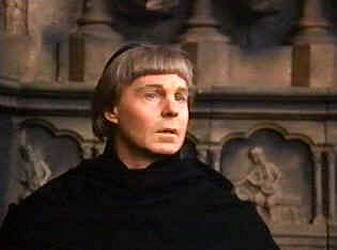
David Suchet was "Clopin Trouillefou".

Gerry Sundquist portrayed "Pierre Gringorie".

The basic story up to the ending follows the novel.
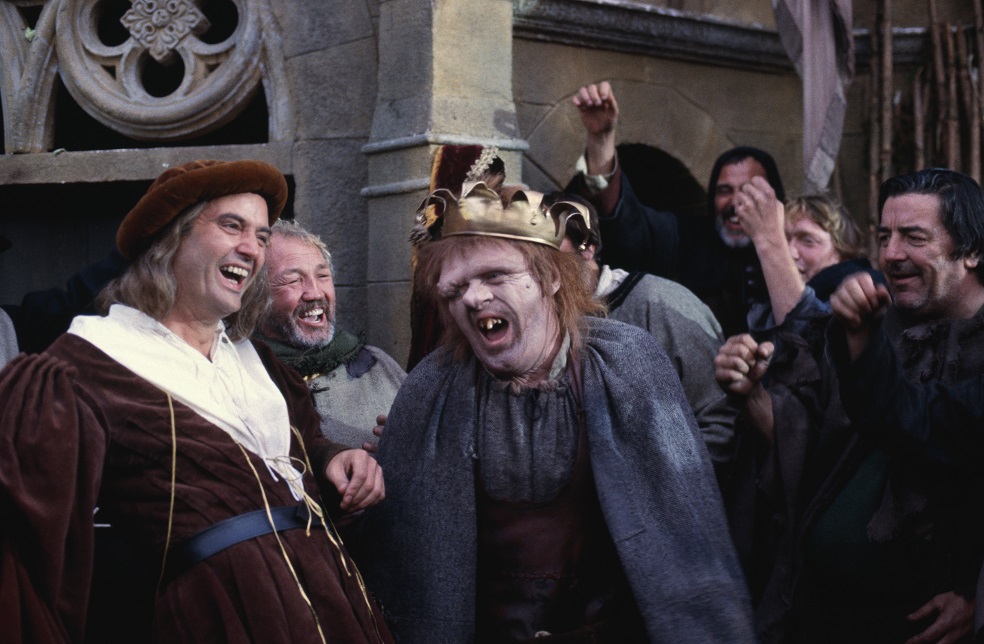
/El%20jorobado%20de%20Notre%20Dame/_derived_jpg_q90_600x800_m0/El%20jorobado%20de%20Notre%20Dame7_1.jpg?partner=allmovie_soap)
The films ending is a series of events starting with "Esmeralda" living and recognizing "Quasimodo's" love for her. She shows this by kissing him good-bye. She then leaves Notre Dame with her husband "Pierre Gringorie". Next "Claude Frollo" attacks "Quasimodo" and in self defense the bell ringer kills the other man by pushing him away and impaling "Claude" on a hook. As a result the soldiers pursue "Quasimodo" believing it was murder. The bell ringer becomes trapped on the parapet of the cathedral and falls to his death asking "Why?".
THE ANIMATED PRODUCTIONS
THE HUNCHBACK OF NOTE DAME (1986)
This is an Australian-American animated feature by the Australian company "Burbank Films". .
The 1986 production closely follows Victor Hugo's story except for the ending. The following are some stills from it.



The 1986 version ends with "Phoebus" still alive and coming through the crowd storming Notre Dame to save "Esmeralda". As "Quasimodo" pushes the evil "Frollo" aside, not killing him, and "Esmeralda" remarks that the bell ringer is:
In 1996 the company changed its name slightly to the "Burbank Animation Studios" and released a second version of "The Hunchback of Notre Dame". There is some confusion, probably deliberately created, concerning the second version of the story, because the Walt Disney Animation Studio, located in "Burbank, California", released their own production of Victor Hugo's work that year.
Here are some scenes from Burbank Studio's 1996 version. It also follows the novel, but without the character of "Pierre Gringorie" and compared to their previous version the animation is very simplistic.

Above "Esmeralda" and below the very cartoonish, compared to the company's first film, "Quasimodo".
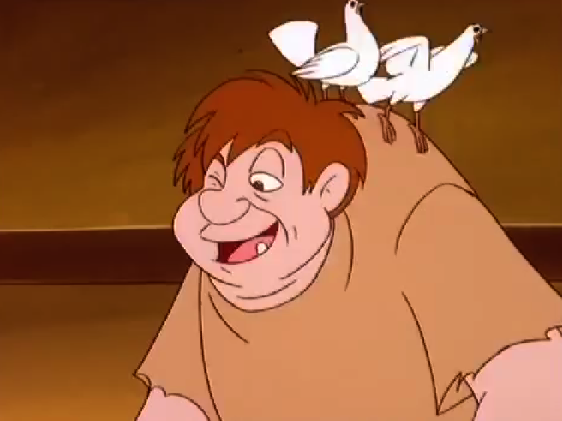

Above "Claude Frollo" and below "Phoebus" with "Esmeralda"

WALT DISNEY PRODUCTIONS THE HUNCHBACK OF NORTE DAME (1996)

In 1482 Paris, the gypsy puppeteer, voiced by Paul Kandel, named "Clopin Trouillefou" tells the audience the story.
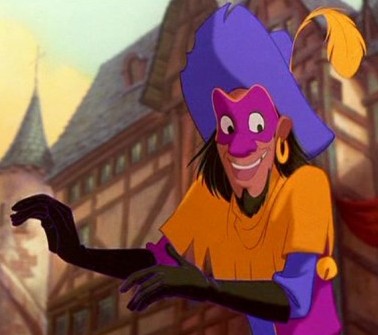
A group of gypsies illegally enter the city and "Judge Claude Frollo", voiced by Tony Jay, has his soldiers kill them, but before he can kill one women's deformed baby. The baby boy is rescued by the archdeacon and for his sin of murder. "Claude Frollo" reluctantly adopts the baby as his ward and names him "Quasimodo", voiced by Tom Hulce.

Switch to 20 years later and "Quasiamodo" lives in the bell tower of Notre Dame Cathedral.
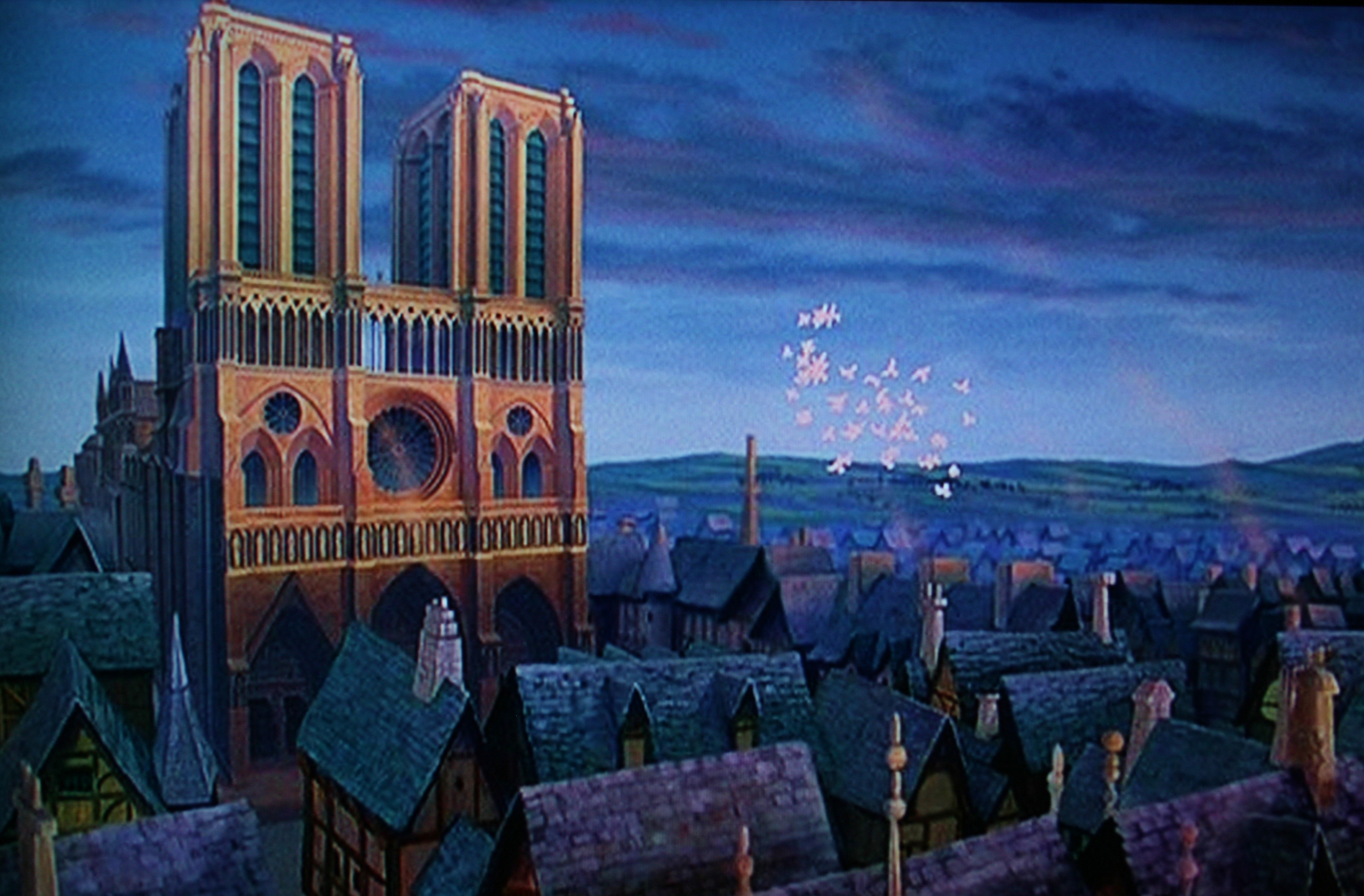
In typical Disney fashion "Quasimodo's" only friends are three gargoyles, who come to life for him, named "Victor", "Hugo" and "Laverne". A little inside joke here.
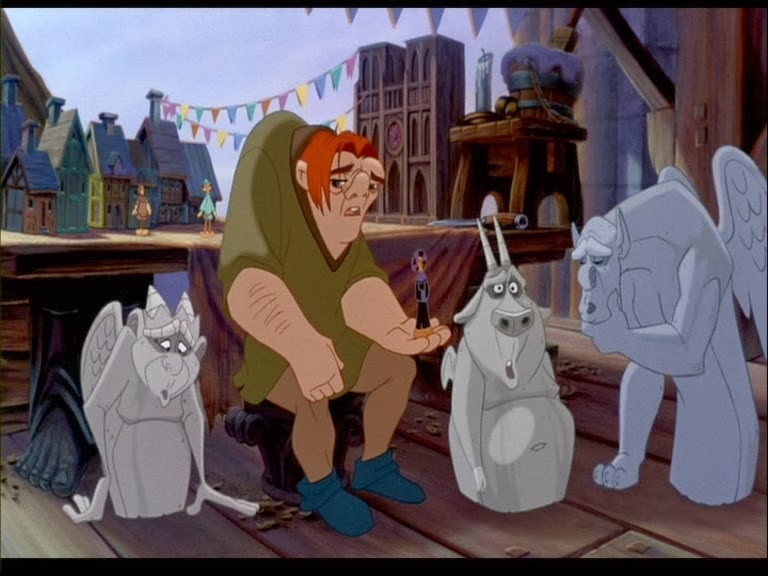
At the annual "Festival of Fools" the young bell ringer decides to go, but is warned by "Frollo" that he will only be humiliated. He still attends and is made the "King of the Fools" and celebrated by the crowd. Until two of "Frollo's" soldiers make fun of him and the crowd turns against.

After attempting to kidnap "Esmeralda", voiced by Demi Moore, as ordered by "Frollo". "Quasimodo" is lashed, but it is the girl that brings him the water no one else would do."Claude Frollo" realizes he has feelings for the gypsy girl, but believes they come from the devil and she's a witch.
Later "Esmeralda" follows "Quasimodo" into Notre Dame, but is being followed by "Captain Phoebus", voiced by Kevin Kline. He refuses "Frollo's" orders to arrest "Esmeralda" for witchcraft and instead has her confined in the cathedral.
"Esmeralda" befriends "Quasimodo" who helps her escape to the "Court of Miracles".

After "Esmeralda's" escape from Notre Dame "Claude Frollo" can't locate the gypsy girl in the cathedral. He then orders a city wide search to find her. "Phoebus" is against this and is sentence to death by "Frollo".
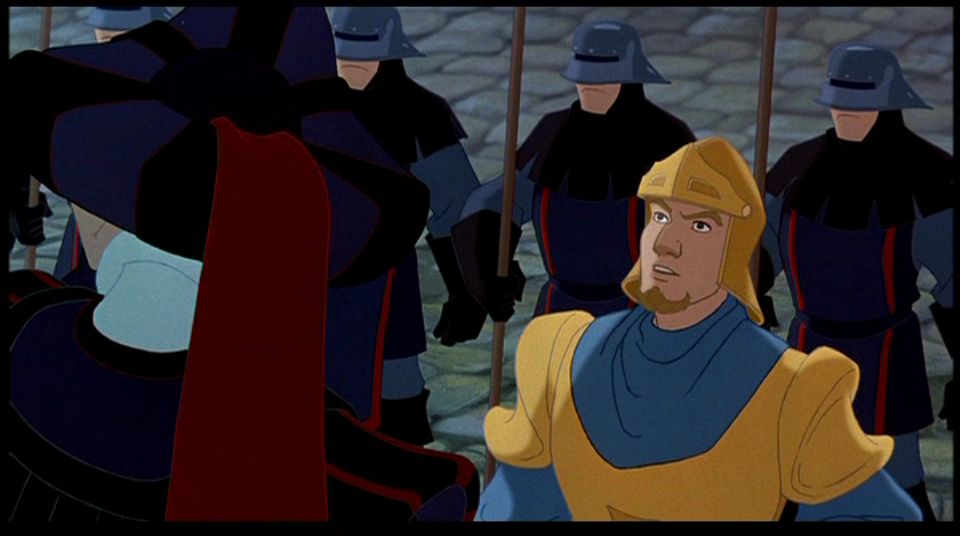
When he attempts to escape "Phoebus" is shot with an arrow and falls into the river Seine. Only to be rescued by "Esmeralda" and the two start to fall in love.

"Claude Frollo" confronts "Quasimodo" over helping "Esmeralda" escape. He knows about the "Court of Miracles" and plans to attack it with a 1,0000 men. "Quasimodo" finds "Phoebus" and tells him of "Frollo's" plan only to be captured in the attack.
"Frollo" prepares to burn "Esmeralda" at the stake, but "Quasimodo" rescues her and takes her back into Notre Dame. "Phoebus" releases the gypsies from prison and rallies the citizens against "Claude Frollo". They march on Notre Dame as "Quasimodo" and the gargoyles throw stones and pour molten lead into the streets. However in the confusion of the battle "Claude Frollo" is able to enter the cathedral.
"Quasimodo" and "Frollo" fight on the balcony as "Esmeralda" looks on. Both men fall over and "Frollo" ends up dead in the molten lead. While "Phoebus" had reached out and saved "Quasimodo".
In the end "Esmeralda" and "Phoebus" convince "Quasimodo" to go out into the streets of Paris. Where the citizens consider him a hero and a friend.
On March 19, 2002 a straight to DVD sequel entitled "The Hunchback of Notre Dame II" was released. The story is set 6 years after the first film. The three leads from the feature film Tom Hulce as "Quasimodo", Demi Moore as "Esmeralda" and Kevin Kline as "Phoebus" are back. Jennifer Love Hewett voices "Madeline" a circus performer that at first is a afraid of "Quasimodo", but falls in love with him. There is a series of robberies and "Phoebus" ties them to the circus and at first thinks its "Madeline". The villain is the magician and circus owner "Sarousch" voiced by Michael McKean.
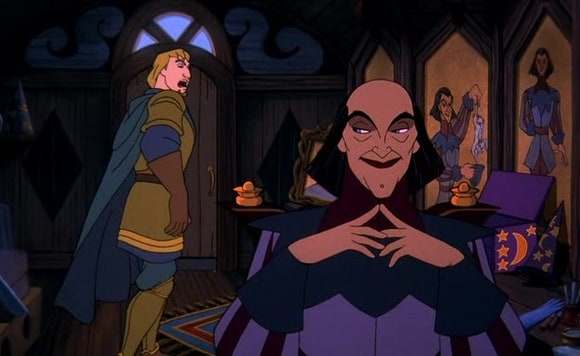

THREE ODD FILMS SUGGESTED BY VICTOR HUGO'S NOVEL
THE DARLING OF PARIS (1917)
Produced by American Fox Films this was a reworking of the story with changes made not to upset religious groups with a screenplay that only suggests the original novel.

Glenn White portrayed "Quasimodo".Theda Bara, a very popular silent film star, was "Esmeralda".Walter Law was "Claude Frollo" now only a surgeon and not a priest. The change I mentioned, because of the pressure being placed on film makers by religious groups.
Herbert Hayes was "Captain Phoebus".Louis Dean was "Pierre Gringorie".John Webb Dillon was Clopin Throuilleou".
The wealthy girl "Esmeralda" is kidnapped at birth by gypsies. She becomes a dancing girl. Both "Frollo" and "Phoebus" are evil. "Quasimodo" is downplayed in this version, but in the end after a series of events. "Frollo" kills "Phoebus" and blames "Esmeralda", but is caught, "Esmeralda" marries "Quasimodo" and is reunited with her wealthy family for a happy ending..
BIG MAN ON CAMPUS (1989)
This is a comedy set in 1989 and is also known as "The Hunchback of UCLA." and "The Hunchback of LA".

Instead of "Quasimodo" the film's title character is "Bob Maloogaloogaloogalooga", say that 10 times fast, or even once.
"Bob" lives in the bell tower of UCLA in Westwood, California. He is put on trial for trespassing and also is subject of scientific research. He falls in love with one of the researchers and her with him. In the end they live happily ever after.
QUASIMODO OF D' EL PARIS (1999)
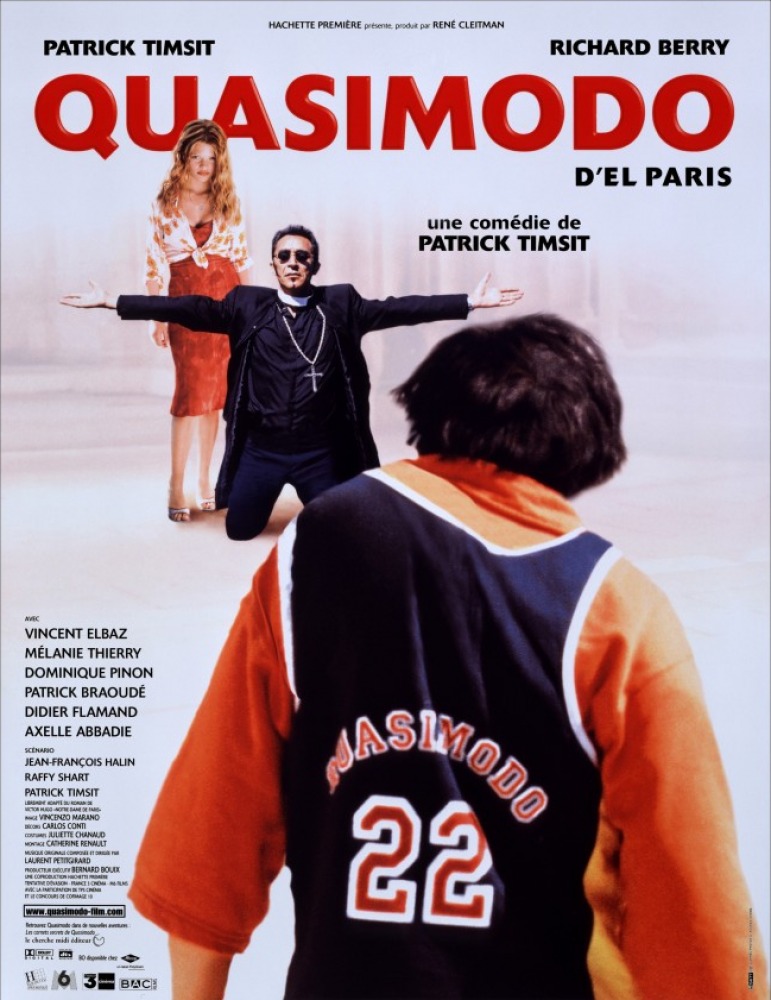
This time its a French comedy set in the town of "El Paris".
Comedian Patrick Timsit portrays "Quasimodo".

Richard Berry is "Serge Frollo" and Melanie Thierry has the dual role of "Agnes" and "Esmeralda".
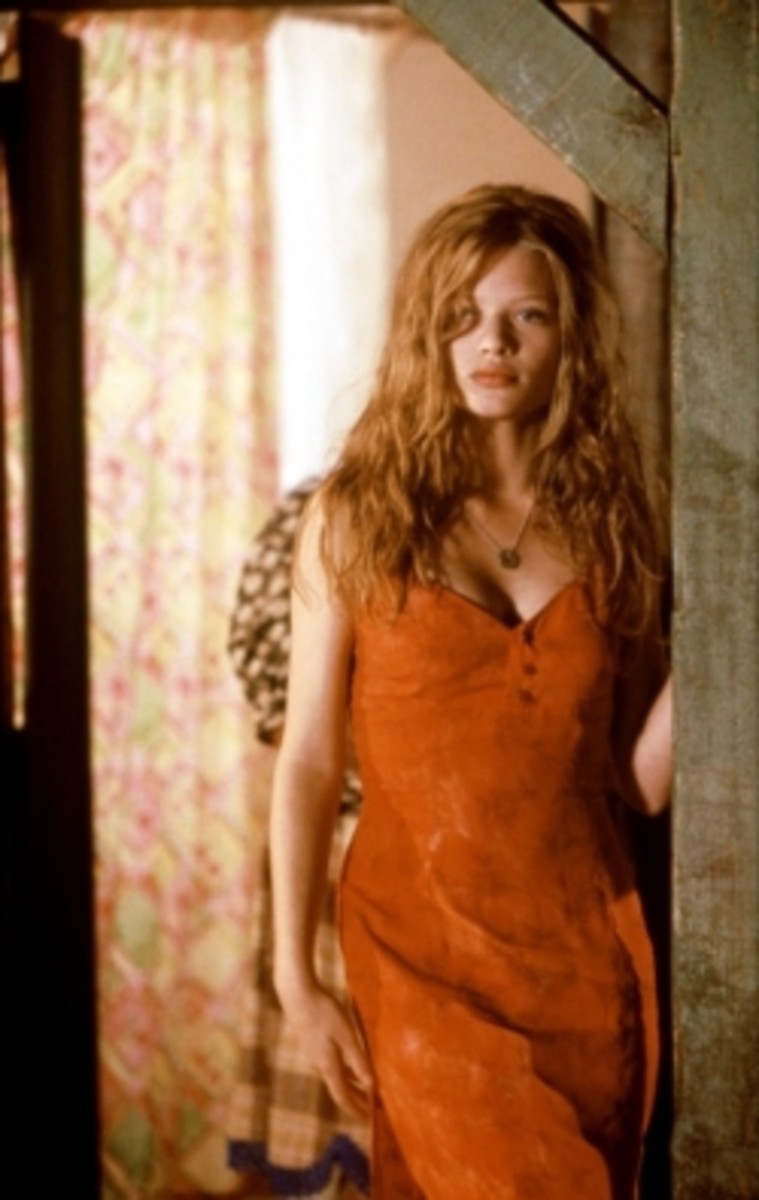
When their ten year old boy "Quasimodo" starts to show signs of a deformity. His wealthy parents place him in the hands of Evangelist "Serge Frollo". To replace him the parents now adopt a Cuban girl from a lower class named "Esmeralda". Whom they now call "Agnes".
A series of killing starts to take place and the blame falls on "Quasimodo". Who must prove himself innocent and find the real killer. Any guesses?


There are both stage drama and at least one musical stage version of Victor Hugo's classic today. I am sure another film will eventually be made. Until then these 15 productions should give me reader an excellent selection.
Above is the actual title for this French and Italian co-production. When the picture was released in the United States, in 1957, the title was changed to "The Hunchback of Notre Dame". Initially there had been a problem with what to call the movie in the United States, because RKO's 1939's version still held the rights to that title, but by the date of release it had become available..


French director Jean Delannoy was in charge of the first production of the Victor Hugo's novel in Technicolor and CinemaScope. There were three writers on the project. Two of them were French Jean Aurenche and Jacques Prevert. The third was American playwright and screenplay writer Ben Hecht. Hecht had written both the novel and screenplay for the original 1932 "Scarface", the screenplay for the original 1937 "A Star is Born". Among his other work were Howard Hawks 1951's "The Thing from Another World", 1955's "Ulysses" starring Kirk Douglas as Homer's hero and 1957's "Legend of the Lost" that starred John Wayne and Sophia Loren.
This screenplay is the closest to the actual novel still, as of this writing, and contains Victor Hugo's actual ending.
The two leading actors were the only one's speaking English on the set. As was typical with many French and Italian productions. The actors spoke their normal language and were dubbed into the language of the country the movie would be shown.
Anthony Quinn was "Quasimodo". Earlier in 1956 Quinn had been seen as "Paul Gauguin", opposite Kirk Douglas as "Vincent Van Gogh", in the excellent biography "Lust for Life". The year before this picture Anthony Quinn was also seen in the Italian language film "Ulysses" with Douglas also.

Gina Lollobrigida was "Esmeralda". Earlier in 1956 she had come between aerialists Burt Lancaster and Tony Curtis in the European set circus film "Trapeze".

French actor Jean Danet was "Phoebus de Chateaupers". Danet was a Gay activist in France during his lifetime and joined in many protests early in his career.

"Claude Frollo" was portrayed by Alain Curry. .


Phillipe Clay is "Clopin Trouillefou". Clay was a known French mime and singer.

French actor Robert Hirsch portayed "Pierre Gringorie". He had been a member of the "Societarie Comedie Francaise" for four years prior to making this picture.

Jean Tissier portrayed "Louis XI" and in this story "Louis" isn't kind as in the 1939 picture, but as portrayed by Victor Hugo as historically evil. Far worse than "Claude Frollo". By the end of his career Tissier had appeared in over 250 different film roles.
Note the make-up, below, on Anthony Quinn as "Quasimodo". He only has a slight bend to his spine and his face is not majorly deformed as in previous films. Quinn plays "Quasimodo" more as a disabled human being with deep emotions than the actors in the previous productions.

The film opens with "Grinorie's" play beginning and the audience hating it and wanting the "Feast of Fools" to start. "Claude Frollo" is walking near Notre Dame and sees "Esmeralda" perform a dance and it is obvious he lusts for her.
The contest for the "King of Fools" starts and "Esmeralda" suggests "Quasimodo". The night as the beggars and thieves are still carrying "Quasimodo" on his throne. "Claude Frollo" appears and removes his crown and robe, but "Quasimodo" retrieves a whistle> As the deaf bell ringer was able to hear it and it brought real joy to him.

As the two are heading back to Notre Dame. "Esmeralda" is walking down the darken street and the lust he feels toward her comes over "Frollo". Who orders "Quasimodo" to bring her to him. This will lead to the appearance of "Phoebus" and his soldiers and the capture of the bell ringer.

"Phoebus" tries to take "Esmeralda" to an inn he uses with women, but she teases him and leaves. "Gringorie" is walking down another darken street and meets a beggar with one leg who demands money. "Gringorie" walks away, but meets another beggar and than even more beggars ending up an uninvited guest at the "Court of Miracles". He is about to be hanged, but "Esmeralda" offers to marry him and saves his life.
Of course she will not go to bed with him, but the two become a team using her goat, that appears to spell, to make money off people. "King Louis XI" goes to "Claude Frollo" to find out, if he can really turn lead into gold. He is looking for any means of funding his kingdom.
"Quasimodo" is brought forth to be lashed and as this is going on. He asks for water and is refused. "Claude Frollo" ignores his plea,.but it is "Esmeralda" that brings him some and he thanks her.


The following day "Claude Frollo" notices "Esmeralda" and "Gringorie" with her spelling goat. The goat picks tiles and spells "Phoebus". "Esmeralda" now meets at the inn with "Phoebus" and was seen going there by the lustful "Claude". Inside he hears the two talking and "Phoebus" jokes about a knife "Esmeralda" has and tosses out the window. It falls in front of "Frollo" who picks it up and stabs him.

"Esmeralda" screams and the owners of the inn look in. She is arrested for the stabbing of "Phoebus" and put on trial. She keeps asking, if "Phoebus" is a live. She is next tortured and sentenced to hang for her crime. The one person that makes the case for conviction is "Claude Frollo". Who is still torn between his lust for "Esmeralda" and his position.

"Esmeralda" is led through the streets to be hanged. Along with her goat that the court considers a familiar of the gypsy witch. "Quasimodo" see this, throws down a rope from the ramparts of Notre Dame, climbs down and grabs the girl. He runs into the cathedral calling for "Sanctuary".
At first "Esmeralda" is frightened, but "Quasimodo" wins her over. However, she has met "Claude Frollo" in the bell tower and confronts him with the truth that he is the one who stabbed "Phoebus".

There are several tender moments in this version between "Esmeralda" and "Quasimodo". Such as the bell ringer showing the gypsy girl his bells and bringing her flowers. It becomes very apparent that "Quasimodo" is in love with "Esmeralda".



Looking down one day from the bell tower. "Esmeralda" spots "Phoebua" and asks "Quasimodo" to bring him to her.
When "Quasimodo" is finally able to speak to "Phoebus". "Phoebus" tells "Quasimodo" he has no feelings for "Esmeralda" and is to marry, within his station, the boring "Fleur de Lys".

"Claude Frollo" talks to "King Louis XI" about finding a way around the "Sanctuary Law". They discover that if the King declares Notre Dame not a church for one day, which he legally can do, then there is no Sanctuary. Which the King does in return for the loyalty "Frollo" gives him. Meanwhile, "Clopin" and his beggars and thieves decide to storm Notre Dame and rescue "Esmeralda".

However, "Quasimodo" sees the crowd and thinks they're coming to harm the girl. So he bars the doors and from the ramparts of the bell tower starts to drop heavy concrete blocks. He gets from the continuing repairs on the cathedral. He also drops a large wooden brace which the crowd uses as a battering ram.
Also stirring up the beggars is "Jehan Frollo" on a horse. A construction ladder is placed high enough for his to reach the bell tower and "Jehan" claims it. Only to have "Quaismodo" push him away and fall to the ground below dead. While his brother watches unemotionally from a corner of the ramparts. A vat of molten lead is near by and "Quasimodo" now pours it out and it runs over the balcony onto the crow below.
When the King's Bowmen arrive to attack the crowd. "Esmeralda" has been able to run down to the cathedral's doors that are now pushed open. However, the bowmen start firing arrows at the crowd and she is hit by one. "Esmeralda" dies in the arms of "Clopin". Who is himself killed by a sword.

When asked about her "Phoebus" says she was to have been hanged. So carry out the sentence and hang her dead body. "Quasimodo" watches "Esmeralda's" body being dragged from Notre Dame and across the court yard. He sees "Claude Frollo" in the corner looking down at "Esmeralda's" body. In a fit of anger "Quasimodo" grabs "Frollo" and tosses him off the ramparts.
Then in a voice over it is mentioned were "Esmeralda's" body was place after being hung. "Quasimodo" enters the crypt to find it just tossed on the dirty floor. He lays down beside his love. As the audience hears that years later the skeleton's of a women and man were discovered intertwined. When it was attempted to separate the two. They turned to dust and were blown away.

As was the custom in the 1950's. The movie was turned into a comic book by Dell Comics.

HUNCHBACK OF NOTRE DAME (1966)
In 1966 there was a British six part mini-series based upon Victor Hugo's novel, but other than Peter Woodthrope portrayed "Quasimodo", Gay Hamilton was "Esmeralda" and James Maxwell was "Claude Frollo". I could not locate any other information about the production except this photo.

HUNCHBACK OF NOTRE DAME (1977)
This production was made by the British Broadcasting Company (BBC).
Warren Clarke was "Quasimodo". Clarke would appear in motion pictures with Charlton Heston and Clint Eastwood. His first major film appearance was in Stanley Kubrick's 1972 "A Clockwork Orange" as one of Malcolm McDowell's droogs.

Michelle Newell was "Esmeralda". Mostly a British television actress. Newell had appeared with Clarke on the popular series "Coronation Street".
/5.jpg)
Richard Morant portrayed "Phoebus de Chateaupers".

In this production "Claude Frollio" is back to being the Archdeacon of Notre Dame cathedral. The role is portrayed by Kenneth Haigh. Haigh was the British World War 1 flyer who lands on a modern 1960 air field in the first season of the original "Twilight Zone" in the episode "The Last Flight".

Tony Caunter was "Clopin Trouillefou".

Christopher Gable was "Pierre Gringorie".

David Rintoul was "Jehan Frollo".

John W. Ratcliff is "Robin Poussepain" a friend of "Jehan". Below both characters with "Quasimodo".

The production opens with "Gringorie's" play, but the audience isn't interested. Especially "Jehan Frollo" and his friend "Robin" that want to start the "Festival of Fools". "Quasimodo" is elected the "King of Fools". However, "Claude Frollo" objects and starts to take the bell ringer away. When "Robin" draws "Frollo's" attention to the dancer "Esmeralda".

"Gringorie" starts to follow "Esmeralda" and sees "Quasimodo" attempt to kidnap the girl, but is unaware that "Claude Frollo" ordered the bell ringer to do this. "Phoebus" and his bowman arrive and arrest "Quasimodo". "Esmeralda" is captivated by the Captain, but leaves. "Gringorie" wanders into another street and is captured by the beggars and taken to their "Court of Miracles". He is saved from hanging by marrying "Esmeralda".
The production continues with the lashing of "Quasimodo" and "Esmeralda" giving him the water he is asking for. After this sequence the audience sees "Jehan" enter the room that his brother "Claude" is performing alchemy. He begs for more money from " Claude" and then explains what he calls the "squalid melodrama" revolving around the gypsy girl, "Esmeralda', and "Phoebus", "Captain of the Bowman". "Jehan" also tells his brother that the two potential lovers will be together that evening and where.
"Claude Frollo" confronts "Phoebus" about lowering himself in station for a gypsy witch. "Phoebus" permits "Claude" to hide and watch him make his move on "Esmeralda". However, she tells the bowman she must remain chaste. The lustful "Claude" steps into the room from his hiding place and stabs "Phoebus".
"Esmeralda" is put on trial for the "murder", which has not actually occurred, of "Phoebus". She is convicted of the crime, but "Claude" appears at her cell. Telling the girl he can free her, if she becomes his. She refuses for the third time. "Gringorie" attempts to get "Claude" to free her, but "Frollo" wants "Esmeralda" taken to the gallows.

"Quasimodo" stops the execution and throws the executioner into the crowd. He takes "Esmeralda" into the church yelling for "Sanctuary".

Later "Esmeralda" sends "Quasimodo" to "Phoebus". "Phoebus" kicks "Quasimodo" to the ground telling him he doesn't want anything to do with the gypsy girl. Returning to "Esmeralda" she starts to strike him over and over again. While stating she "Hates him". Next "Claude Frollo" attempts to rape the girl and "Quasimodo" comes to her rescue. Upon realizing the rapist is his adoptive father "Frollo". The bell ringer begs to be killed for what he has seen and done for him, but "Claude" will not carry out the request. He next states to "Quasimodo" and "Esmeralda" that nobody will ever have the girl, but himself.
"Clopin" and the beggars attempt to rescue "Esmeralda". "Quasimodo" starts throwing things down upon the beggars believing they're attacking the cathedral to harm the gypsy girl. "Clopin" and "Gringorie" manage to get the girl and take her outside, but "Claude Frollo" is there to block him.
"Gringorie" now thinking only for himself. Apologizes to "Frollo" for being part of the crowd attempting to free "Esmeralda" and is told to leave. While "Claude Frollo" gives the girl to the hangman. As "Phoebus" and his men continue to kill the beggars, thieves and "Jehan Frollo".
"Quasimodo" begs "Claude" to save "Esmeralda", but when the other smiles at the girl being hanged. "Quasimodo" throws him off the ramparts to his death. While the bodies of all the dead are being removed around Notre Dame. "Captain Phoebus" and his bride "Fleur de Lys" dance with their guests at their wedding.
THE HUNCHBACK OF NOTRE DAME (1982)
This is a British-American made for television motion picture sometimes just called "The Hunchback". In the United States the feature was seen on the "Hallmark Channel" that was the main producer. This version also introduces several characters not seen in any other, but changes the ending of Victor Hugo's novel even more than any previous feature except 1956.
Anthony Hopkins portrayed "Quasimodo". The previous year the actor starred as William Shakespeare's "Othello" on British television and in 1980 appeared with John Hurt in "The Elephant Man". It would be nine years after this movie that Anthony Hopkins first became "Hannibal Lecter" in "Silence of the Lambs".

Lesley-Anne Downs was "Esmeralda". In 1973 she first appeared on the classic British television show "Upstairs, Downstairs" for the next two years. The actress had third billing in 1976's "The Pink Panther Strikes Again" and would be seen on American television in both of the all star mini-series "North and South" and its sequel "North and South Book 2".

Robert Powell was "Captain Phoebus". He would play "Jesus" in the major 1977 mini-series "Jesus of Nazareth" and was "Victor Frankenstein" in a 1984 television producer with David Warner as his creation.

Derek Jacobi portrayed "Claude Frollo".

David Suchet was "Clopin Trouillefou".

Gerry Sundquist portrayed "Pierre Gringorie".

The basic story up to the ending follows the novel.

/El%20jorobado%20de%20Notre%20Dame/_derived_jpg_q90_600x800_m0/El%20jorobado%20de%20Notre%20Dame7_1.jpg?partner=allmovie_soap)
The films ending is a series of events starting with "Esmeralda" living and recognizing "Quasimodo's" love for her. She shows this by kissing him good-bye. She then leaves Notre Dame with her husband "Pierre Gringorie". Next "Claude Frollo" attacks "Quasimodo" and in self defense the bell ringer kills the other man by pushing him away and impaling "Claude" on a hook. As a result the soldiers pursue "Quasimodo" believing it was murder. The bell ringer becomes trapped on the parapet of the cathedral and falls to his death asking "Why?".
THE ANIMATED PRODUCTIONS
THE HUNCHBACK OF NOTE DAME (1986)
This is an Australian-American animated feature by the Australian company "Burbank Films". .
The 1986 production closely follows Victor Hugo's story except for the ending. The following are some stills from it.



The 1986 version ends with "Phoebus" still alive and coming through the crowd storming Notre Dame to save "Esmeralda". As "Quasimodo" pushes the evil "Frollo" aside, not killing him, and "Esmeralda" remarks that the bell ringer is:
the most beautiful and innocent man who was ever born.That version ends with "Quasimodo" beside one of Notre Dame's gargoyles looking down upon Paris.
In 1996 the company changed its name slightly to the "Burbank Animation Studios" and released a second version of "The Hunchback of Notre Dame". There is some confusion, probably deliberately created, concerning the second version of the story, because the Walt Disney Animation Studio, located in "Burbank, California", released their own production of Victor Hugo's work that year.
Here are some scenes from Burbank Studio's 1996 version. It also follows the novel, but without the character of "Pierre Gringorie" and compared to their previous version the animation is very simplistic.

Above "Esmeralda" and below the very cartoonish, compared to the company's first film, "Quasimodo".


Above "Claude Frollo" and below "Phoebus" with "Esmeralda"

WALT DISNEY PRODUCTIONS THE HUNCHBACK OF NORTE DAME (1996)

In 1482 Paris, the gypsy puppeteer, voiced by Paul Kandel, named "Clopin Trouillefou" tells the audience the story.

A group of gypsies illegally enter the city and "Judge Claude Frollo", voiced by Tony Jay, has his soldiers kill them, but before he can kill one women's deformed baby. The baby boy is rescued by the archdeacon and for his sin of murder. "Claude Frollo" reluctantly adopts the baby as his ward and names him "Quasimodo", voiced by Tom Hulce.

Switch to 20 years later and "Quasiamodo" lives in the bell tower of Notre Dame Cathedral.

In typical Disney fashion "Quasimodo's" only friends are three gargoyles, who come to life for him, named "Victor", "Hugo" and "Laverne". A little inside joke here.

At the annual "Festival of Fools" the young bell ringer decides to go, but is warned by "Frollo" that he will only be humiliated. He still attends and is made the "King of the Fools" and celebrated by the crowd. Until two of "Frollo's" soldiers make fun of him and the crowd turns against.

After attempting to kidnap "Esmeralda", voiced by Demi Moore, as ordered by "Frollo". "Quasimodo" is lashed, but it is the girl that brings him the water no one else would do."Claude Frollo" realizes he has feelings for the gypsy girl, but believes they come from the devil and she's a witch.
Later "Esmeralda" follows "Quasimodo" into Notre Dame, but is being followed by "Captain Phoebus", voiced by Kevin Kline. He refuses "Frollo's" orders to arrest "Esmeralda" for witchcraft and instead has her confined in the cathedral.
"Esmeralda" befriends "Quasimodo" who helps her escape to the "Court of Miracles".

After "Esmeralda's" escape from Notre Dame "Claude Frollo" can't locate the gypsy girl in the cathedral. He then orders a city wide search to find her. "Phoebus" is against this and is sentence to death by "Frollo".

When he attempts to escape "Phoebus" is shot with an arrow and falls into the river Seine. Only to be rescued by "Esmeralda" and the two start to fall in love.

"Claude Frollo" confronts "Quasimodo" over helping "Esmeralda" escape. He knows about the "Court of Miracles" and plans to attack it with a 1,0000 men. "Quasimodo" finds "Phoebus" and tells him of "Frollo's" plan only to be captured in the attack.
"Frollo" prepares to burn "Esmeralda" at the stake, but "Quasimodo" rescues her and takes her back into Notre Dame. "Phoebus" releases the gypsies from prison and rallies the citizens against "Claude Frollo". They march on Notre Dame as "Quasimodo" and the gargoyles throw stones and pour molten lead into the streets. However in the confusion of the battle "Claude Frollo" is able to enter the cathedral.
"Quasimodo" and "Frollo" fight on the balcony as "Esmeralda" looks on. Both men fall over and "Frollo" ends up dead in the molten lead. While "Phoebus" had reached out and saved "Quasimodo".
In the end "Esmeralda" and "Phoebus" convince "Quasimodo" to go out into the streets of Paris. Where the citizens consider him a hero and a friend.
On March 19, 2002 a straight to DVD sequel entitled "The Hunchback of Notre Dame II" was released. The story is set 6 years after the first film. The three leads from the feature film Tom Hulce as "Quasimodo", Demi Moore as "Esmeralda" and Kevin Kline as "Phoebus" are back. Jennifer Love Hewett voices "Madeline" a circus performer that at first is a afraid of "Quasimodo", but falls in love with him. There is a series of robberies and "Phoebus" ties them to the circus and at first thinks its "Madeline". The villain is the magician and circus owner "Sarousch" voiced by Michael McKean.


THREE ODD FILMS SUGGESTED BY VICTOR HUGO'S NOVEL
THE DARLING OF PARIS (1917)
Produced by American Fox Films this was a reworking of the story with changes made not to upset religious groups with a screenplay that only suggests the original novel.

Glenn White portrayed "Quasimodo".Theda Bara, a very popular silent film star, was "Esmeralda".Walter Law was "Claude Frollo" now only a surgeon and not a priest. The change I mentioned, because of the pressure being placed on film makers by religious groups.
Herbert Hayes was "Captain Phoebus".Louis Dean was "Pierre Gringorie".John Webb Dillon was Clopin Throuilleou".
The wealthy girl "Esmeralda" is kidnapped at birth by gypsies. She becomes a dancing girl. Both "Frollo" and "Phoebus" are evil. "Quasimodo" is downplayed in this version, but in the end after a series of events. "Frollo" kills "Phoebus" and blames "Esmeralda", but is caught, "Esmeralda" marries "Quasimodo" and is reunited with her wealthy family for a happy ending..
BIG MAN ON CAMPUS (1989)
This is a comedy set in 1989 and is also known as "The Hunchback of UCLA." and "The Hunchback of LA".

Instead of "Quasimodo" the film's title character is "Bob Maloogaloogaloogalooga", say that 10 times fast, or even once.
"Bob" lives in the bell tower of UCLA in Westwood, California. He is put on trial for trespassing and also is subject of scientific research. He falls in love with one of the researchers and her with him. In the end they live happily ever after.
QUASIMODO OF D' EL PARIS (1999)

This time its a French comedy set in the town of "El Paris".
Comedian Patrick Timsit portrays "Quasimodo".

Richard Berry is "Serge Frollo" and Melanie Thierry has the dual role of "Agnes" and "Esmeralda".

When their ten year old boy "Quasimodo" starts to show signs of a deformity. His wealthy parents place him in the hands of Evangelist "Serge Frollo". To replace him the parents now adopt a Cuban girl from a lower class named "Esmeralda". Whom they now call "Agnes".
A series of killing starts to take place and the blame falls on "Quasimodo". Who must prove himself innocent and find the real killer. Any guesses?


There are both stage drama and at least one musical stage version of Victor Hugo's classic today. I am sure another film will eventually be made. Until then these 15 productions should give me reader an excellent selection.
_02.jpg)







